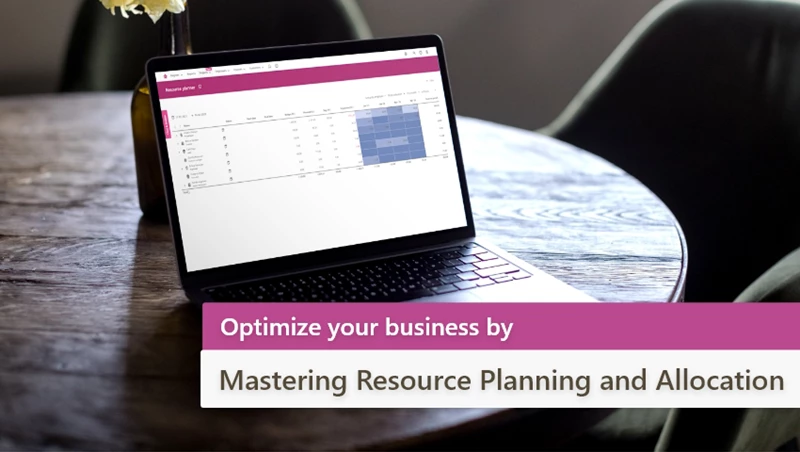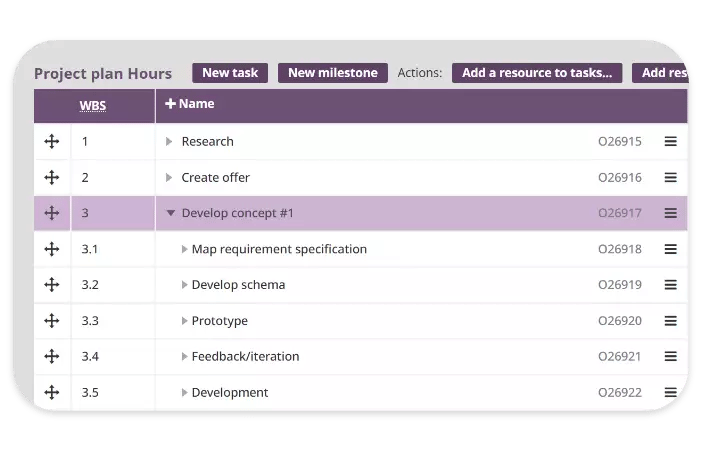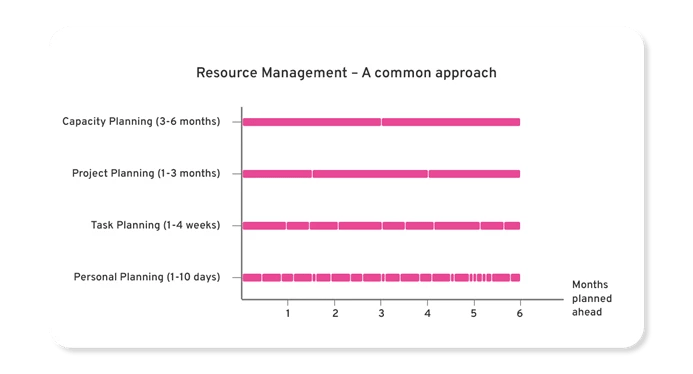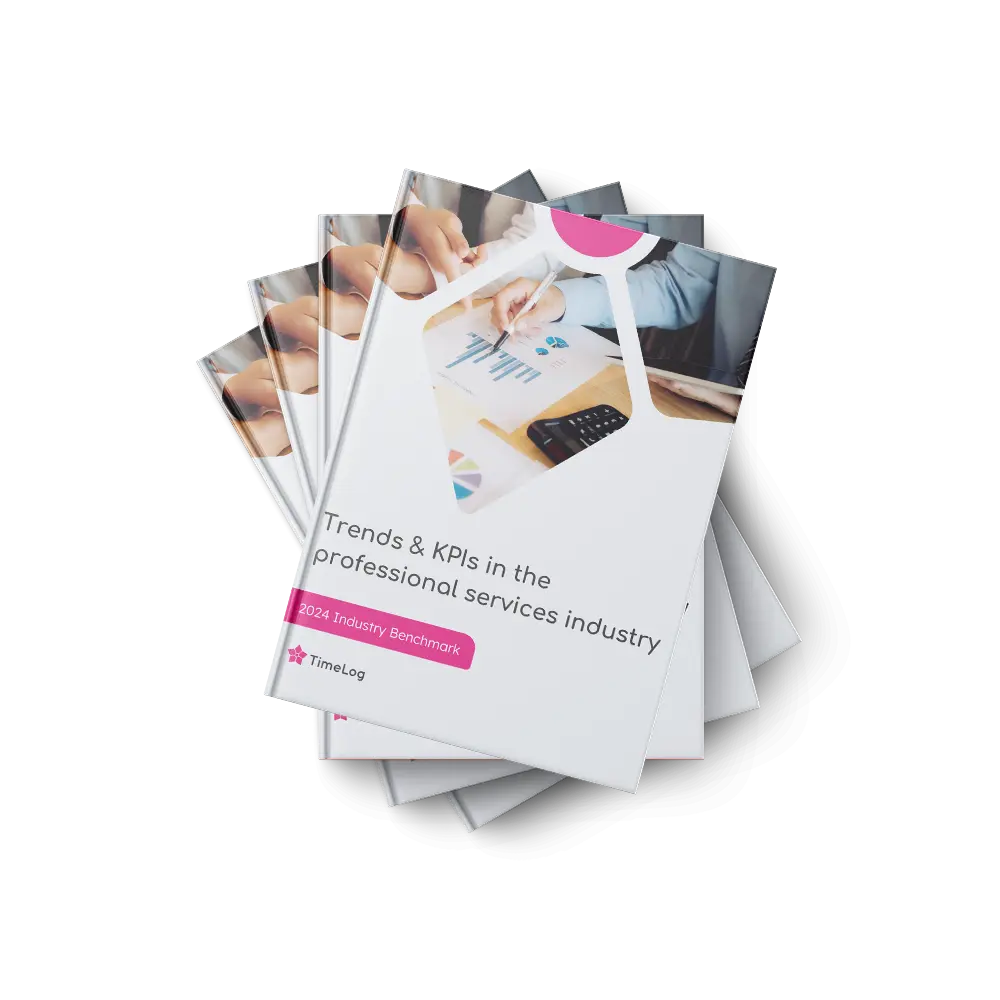Guide: Resource management [4 things you need to get right]
8 min read
Time tracking
Build your perfect data foundation for spotless invoicing and deep business insights with easy time tracking.
Project management
Be a world champion project manager. Keep your projects on track - and profitable.
Resource management
Efficiently staff projects and run a predictable business with confidence.
Insights & Reporting
Get smarter - faster - to make clever decisions for long-term growth impact.
Project accounting & Invoicing
Invoice everything - fast and accurate - while staying on top of project finances.
Staff & Salary
Give accountants and HR an intelligent tool to eliminate draining administration.
Financial Systems
TimeLog offers standard integrations for all your favourite financial systems. Save time and reduce manual tasks.
Payroll Solutions
TimeLog offers standard integrations for multiple payroll solutions. Get easy salary administration and only enter payroll information once.
Add-ons
Track time automatically via Outlook, use gamification or find another add-on that can support your business.
Multiple Legal Entities
You can create synergy between your departments and across borders and offices with the Multiple Legal Entities module from TimeLog.
Business Intelligence
Utilise the insights you get from TimeLog to the fullest. Our system is ready to integrate with multiple BI solutions.
Partner Integrations
TimeLog PSA is part of a large ecosystem. Get an overview of all the partner integrations in the TimeLog family.
Economy department
Save 1-2 days a month on your invoicing process.
Project teams
From planning to execution and evaluation. Robust tools for every project manager.
Management teams
Create a performance-driven culture with solid reporting capabilities.
Large enterprises
Enhance operations and performance across entities, countries and departments.
NGOs and non-profit organisations
Simplify internal processes, spend less time on administration, and get documentation in place - at a discounted rate.
Blog
Get inspired to run an even better business with articles, guides and analyses.
Guides, podcasts and webinars
Get access to templates, guides and webinars that help and inspire you.
Help Center
Looking for help material and user guides to the TimeLog system? Look no further. Find all the help you need now.
Get a single source of truth
Discover how companies maintain a single source of truth across borders, departments, and currencies.
Get integrated
Discover the advantages customers gain from utilising our integrations and API.
Reporting in real-time
Explore how others leverage reporting to optimise their processes and make informed decisions.
Get started with resource planning
Discover how other companies thoroughly grasp their resources and enhance their ability to predict future trends.
Improved project financials
This is how the efficient financial toolbox from TimeLog helps project managers and CFOs improve their project financials.
Faster invoicing
Discover how other companies have slashed the time spent on invoicing by 75% - and uncover how you can achieve the same efficiency.
The Story of TimeLog
Get insights on TimeLog and how we can help you grow and evolve your business.
Employees
See who shows up every day to deliver the best PSA solution.
Career
What's life like at TimeLog? Are we hiring? Get the answer here.
Partner
Create even more value for your customers, as well as ours, as a TimeLog Partner.
Premium Service
Online Help Center, tailored onboarding and support from Day 1.
Corporate Social Responsibility
We work to ensure a positive impact on planet, people and businesses.
Security and GDPR
Learn more about how we work to keep your data safe and provide maximum security.
6 min read
Resource management is the process of identifying and allocating resources to meet business goals. Optimise your business success with effective resource planning.

Resource management is a crucial aspect of your company's operations in driving business success. And it can be a significant turning point for the profitability of the business if you can effectively manage your resources.
It means identifying resource requirements, allocating resources effectively, optimizing resource utilization, managing resource constraints, and monitoring resource usage.
There are different types of resources required for each business — from financial resources to inventory, production resources, human resources, information technology, and natural resources.
In simplest terms, it’s the Tetris game of your company.
Many organizations adopt a common approach to resource planning, assuming that it will lead to efficient allocation of resources and successful project outcomes.
And it often looks like this:

Planning level

1 - 3 Months
Planning level

1 - 4 Weeks
Planning level
1 - 10 Working days
Planning level
However, in practice, this approach often fails, leading to resource over- or underutilization, missed deadlines, and cost overruns. The top three reasons that lead to these pitfalls are:
This is typically the biggest trigger point. Teams often prioritize urgent tasks over important but not urgent ones, such as capacity planning.
Urgent tasks require immediate attention and action, while important but not urgent tasks can be postponed. However, capacity planning is a critical component of resource planning that should not be overlooked.
Capacity planning involves forecasting resource needs and ensuring that there are enough resources available to complete projects within the specified timeline including:
By neglecting capacity planning, resources may become overburdened with work or may not have enough work to do, leading to inefficient resource utilization and missed project deadlines.
To avoid this pitfall: Prioritize capacity planning and allocate sufficient time and resources to it.
Teams can create a capacity plan that outlines the resources needed for each project and the expected utilization rates. This plan should be regularly reviewed and updated to reflect changes in project requirements or resource availability.
Resource planning tools can be highly effective in optimizing resource utilization and ensuring that projects are completed on time. However, these tools need to be integrated with project management tools and time tracking systems to be effective.
Without integration, resource planning can become a disconnected and time-consuming process, leading to errors and inconsistencies in data.
In addition, teams may not have a clear overview of resource availability and utilization rates, leading to suboptimal resource allocation.
To avoid this pitfall: Select resource planning tools that can be seamlessly integrated with project management tools and time tracking systems.
Having proper integrations in place means having access to real-time data on resource availability, utilization rates, and project timelines, enabling teams to make informed decisions about resource allocation.
Resource planning is not just the responsibility of the project manager or the resource manager. It is a team effort that involves all stakeholders in the project, including:
When resource planning is not a team effort, it can result in:
For example, team members may not communicate their resource needs effectively, or department heads may prioritize their department's resources over others.
To avoid this pitfall: Involve all stakeholders in resource planning and ensure that everyone is aligned with the project goals and resource allocation strategies.
Regular communication and collaboration between team members, department heads, and senior management can help ensure that resource planning is a team effort that supports project success.
The lack of updated and trustworthy data can lead to a lack of trust in the information, resulting in process stalls and a reliance on email communication. What happens then?
Typically, it can cause processes to become inefficient and ultimately fail due to a lack of awareness of the need to maintain agility in resource planning.
When you have to spend more time doing manual work, it becomes extremely time-consuming and less time to focus on more important tasks. Additionally, it can lead to errors and inaccuracies, which can have a domino effect on the rest of the project or process.
But these pitfalls don't stop there.
An ineffective resource management can be detrimental for team members who may feel that their skills are not being utilized to their full potential.
Ultimately, relying on manual work hinders productivity and efficiency, which can negatively impact the success of a project or business.

With a well-integrated resource management system, you can quickly identify if the project plan is realistic and alert clients if more resources are needed or if there are any issues.
It's also important to have a Customer Relationship Management (CRM) system to track customer interactions and identify opportunities for business growth. Additionally, time tracking and individual calendars can make planned work visible and keep everyone on the same page regarding project timelines.
When these systems work together, you can create a revenue forecasting process that is supported by data, allowing for informed decisions about project selection and resource allocation for maximum profitability.
Prioritizing resource management ensures efficient and effective resource usage, leading to greater success and business growth.

Many consulting firms face the challenge of ensuring that their projects are profitable due to the nature of their business.
The work they do is typically project-based, and each project has a unique set of requirements and constraints. It can be challenging to accurately estimate the resources required for each project and manage those resources effectively to deliver the project on time and within budget.
Additionally, consulting firms often work with clients who have their own set of goals and priorities, which can sometimes conflict with the firm's profitability goals. All of these factors make it difficult for consulting firms to consistently deliver profitable projects.
According to our latest SPI industry benchmark, we found that resource management most utilized by companies that are in Level 3 of the SPI’s maturity model.
Effective resource management is most directly connected to and is highly critical for the following Key Performance Indicators (KPIs):
This KPI provides insights into the size, scope, and duration of projects, which can be useful for evaluating the organization's performance.
Resource management in itself does not directly increase revenue. However, it provides an overview and tools to increase revenue per project.
By having a better understanding of available resources, an organization can make more informed decisions about which resources to allocate to a project.
This can help avoid the use of the most expensive resources for every project, thereby maximizing revenue for the project.
For instance, by using a mix of resources with different skill sets and experience levels, an organization can ensure that the project is completed efficiently and effectively while also minimizing costs. This approach can lead to higher revenue per project and greater profitability for the organization.
The ability to deliver projects on time is crucial for the success of any service organization, especially for those that bill their clients for the work done.
Project delays can have a negative impact on both profitability and client satisfaction, and thus measuring the percentage of projects delivered on time is an important KPI.
As a company increases its process maturity, there is a reduction in manual work and an increase in automation, which allows team members to focus on delivering work rather than dealing with administrative tasks.
With better resource management in place, teams can allocate resources effectively and plan projects more efficiently, leading to increased likelihood of delivering projects on time.
By consistently meeting project deadlines, a company can build a reputation for reliability, which can lead to repeat business and positive referrals from satisfied clients. Thus, measuring and improving the percentage of projects delivered on time is a key aspect of driving business growth and success.
Having a standardized delivery methodology in place ensures consistent project outcomes and quality. This KPI measures the percentage of projects where a structured delivery methodology is used, which incorporates best practices and knowledge into projects.
A standardized framework typically includes:
This not only streamlines the project delivery process, but also ensures that the same quality standards are applied to every project.
Implementing standardized processes is an important step towards achieving process maturity within a company. By having consistent procedures and practices in place, organizations can more easily identify areas for improvement and optimize their project delivery approach.
Ultimately, this leads to more efficient and effective use of resources, higher quality project outcomes, and improved client satisfaction.
All of these means that the profit in itself rises with effective resource management. But resource management more than just increasing profits.
Effective resource management can also have an indirect positive outcome on employee wellbeing, as it can reduce the stress and anxiety associated with missing deadlines or being overloaded with work.
When projects are delivered on time and there is a clear understanding of the resources needed to complete them, employees can have a more balanced workload, leading to increased job satisfaction and overall well-being. This can also lead to higher employee retention rates and a positive company culture.
The bottom line is, if a business wants to thrive, it's crucial to make resource management a top priority.
Unfortunately, lots of companies take a one-size-fits-all approach to resource planning that falls flat because they don't account for:
When resource management isn't up to snuff, it can cause all kinds of problems like:
The good news is, a solid resource management system that integrates well can be the answer to better use of resources in return for efficiency and stronger business growth.
![Guide: Resource management [4 things you need to get right]](https://timelog.com/hubfs/resource-mng-blog-index-1.webp) Read more
Read more

9 min read
 Read more
Read more

7 min read